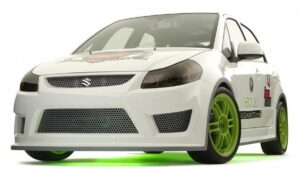Pure Gas-Powered Cars Will Soon be the Minority of Europe's New Vehicle Sales

Photo: Jens Schlueter (Getty Images)
Electrified vehicles are having a moment in Europe, BMW and Stellantis are raking it in and wouldn’t you believe a company that deals primarily in chips for cars isn’t doing the best right now. All that and more in The Morning Shift for Thursday, May 5, 2022.
1st Gear: One of Every 10 Vehicles Sold is an EV
Sales of pure electric vehicles in Europe have doubled in the last year, Reuters reported Thursday citing industry data. Surprisingly, new registrations for battery-electric cars actually exceeded those of plug-in hybrids in the first quarter of 2022:
BEVs accounted for 10% of total passenger car sales in the EU, data from the region’s carmaker association (ACEA) showed, surpassing plug-in hybrid electric vehicles, which took an 8.9% share.
In total, 224,145 BEVs were sold across the EU in the January-March period, up from 146,125 in the same period last year.
Regular hybrids are up big, too:
Hybrid electric vehicles accounted for more than a quarter of the market, up from around a fifth in the same period last year. Cars powered by petrol and diesel lost market share but still accounted for 52.8% of the EU market during the period.
Put those altogether, and almost one out of every two new cars sold between January and March on the continent was electrified in some way. The top seller among plug-in cars (that’s battery-electric and plug-in hybrid) was the Kia Niro EV, followed by the Peugeot 3008 PHEV and Audi Q4 E-Tron, per InsideEVs.
This whole time I’ve been skeptical that manufacturers will really quit internal-combustion engines as quickly as they’ve told their investors they will. At this pace however, some might just pull it off — in Europe, anyway. EV sales records are continually being shattered in the U.S. too of course, though we’re lagging behind our neighbors across the Atlantic. Battery-electric cars accounted for 5.2 percent of new vehicles sales on our shores in the first quarter of 2022, up from 2.5 percent a year earlier, according to data cited by Cox Automotive last month.
2nd Gear: BMW and Stellantis are Doing Alright
Both saw profits rise in the early part of 2022 despite selling fewer cars. In BMW’s case, first-quarter revenues jumped 16.2 percent, even though the German automaker moved 6.2 percent less vehicles than it had a year ago. From Reuters:
A global semiconductor chip shortage has hit car production across the industry, but BMW said demand for its vehicles remained “very robust”.
“Never before in the history of our company have our pre-orders been higher than they are today,” Chief Executive Oliver Zipse said on a conference call. “The markets signal that this high demand will continue.”
As usual, what’s music to executives’ and shareholders’ ears makes me not want to get out of bed in the morning. BMW was trading 1.9 percent higher as of Thursday morning. Meanwhile, Stellantis managed to trade 12 percent of vehicles sold for a 12 percent boost in revenue. From Automotive News:
Net revenue increased 12 percent to 41.5 billion euros ($44.1 billion) in the January-March period, the automaker said in a statement on Thursday.
The automaker, since the PSA-Fiat Chrysler merger, does not disclose quarterly financial performance — only half-year and full-year results.
“Our full-year guidance for double-digit adjusted operating income margins and positive cash-flow is confirmed, despite supply and inflationary headwinds, as good product momentum and strategic partnerships continue to pave the way,” CFO Richard Palmer said in the statement.
Vehicle shipments, however, fell 12 percent in the quarter, mainly because of the impact of unfilled semiconductor orders.
This all despite the fact that Stellantis’ supply has been seriously pinched in Europe in recent months, less so North America. Both manufacturers project semiconductor production will improve only slightly if at all before the end of 2022. Given how demand is so profoundly on their side, I don’t know if either really cares whether the chips start flowing again or not.
3rd Gear: There Will be Nismo EVs
What, did you think Nissan was going to flat-out kill a brand in the age of electrification? Courtesy of Top Gear, which heard it first hand from the Japanese automaker’s chairman in Europe, Guillaume Cartier:
“Nismo is an asset that we have,” explained Cartier, “and that’s something we want to revitalise. And will we have some, let’s say, cars with the derivative Nismo? The answer is yes.”
And Cartier says he doesn’t want this to amount to an appearance package:
“The point is, it’s not a gimmick,” insists Cartier. “To use an English expression, it’s not lipstick on a pig. So that requires some investment to make sure that you bring performance.”
So what does ‘performance’ mean in a Nismo-electric context? “Here it’s relatively easy to understand: specific suspension and powertrain. The point on Ariya, it’s a challenge because already we have a big battery with high performance. So we need to go higher than that.”
Here in the U.S., unless you’re Tesla or Ford specifically in the case of the F-150 Lightning, EVs aren’t sexy. They’re merely a means to an end, in this case not being gouged at the pump. Most carmakers need to lean on anything that might entice shoppers to make the transition — the more irrational and nostalgic, the better. That’s why Volkswagen is making an electric surf van, and why Hyundai keeps restomodding its flagships of the ’70s and ’80s for Instagram.
Nissan is not a brand with a strong performance pedigree today — Z aside, it’s got nothing — and up until now its EV offerings have started and ended with the Leaf. It’ll be desperate to change that perception, and will attempt to accomplish that through Nismo.
4th Gear: Not a Great Time to be in Aptiv’s Line of Work
Electrical component suppliers are getting the short end of the stick, and Aptiv’s first-quarter earnings are indicative of that. From Automotive News:
Aptiv posted lower first-quarter profit on Thursday, as surging raw material prices and a shortage of electrical components hindered the auto part supplier’s deliveries in the quarter.
Net income during the first quarter fell 74 percent to $73 million while revenue rose 4 percent to $4.2 billion, Aptiv said in a statement Thursday.
Aptiv, whose primary customers include Stellantis, Volkswagen and General Motors, supplies several key electrical components and software for modern vehicles that are used for everything from infotainment systems to integrated driver safety systems.
However, rising prices of raw materials and a global semiconductor shortage forced several automakers to slash their production cycles and in some cases even produce cars without certain features, thereby impacting Aptiv’s orders.
As the last two years have proven, carmakers can still sell vehicles without some hardware and thus, some features. But Aptiv is responsible for that hardware, and it can’t make money without selling it. Despite this, shares of the company were up 2.2 percent on Thursday morning. It found a way to survive out of Delphi’s ashes, and maybe it’ll find a way to survive through this.
5th Gear: A 30-Year-Old Truck is Sold Out Through 2024
It’s the Toyota Land Cruiser 70, which you can’t buy here of course, but you still can in Australia. Provided you want to wait, that is. From Drive:
Proving that age is no barrier to success, the iconic Toyota LandCruiser 70 Series – which is now more than three decades old – has a waiting list of up to two and a half years.
Toyota dealers canvassed by Drive said, based on current production rates and forecasts, it will take more than two years to fulfill orders placed today.
However, Toyota dealers say they remain hopeful waiting times for the Toyota LandCruiser 70 Series will be reduced once production ramps up in the coming year or so.
The current model – which dates back to the 1980s – is due to receive another round of safety upgrades by the end of this year, when new side-impact regulations come into force in Australia.
It’s amazing to me that for three decades, Toyota has been in this habit of upgrading the Land Cruiser 70 in various ways to ensure it remains compliant with Australia’s new car regulations. Most manufacturers would just discontinue the offending model and move onto the next.
Neutral: 15 Minutes, 116 Miles High
Reverse: What’s Stopping You?
What keeps me from going pure electric? The infrastructure thing, coupled with the fact that I live in an apartment so I can’t just plug in overnight. To a lesser extent, probably the idea of weight impacting the driving feel — but that’s something I could probably get over in time. How about you?





